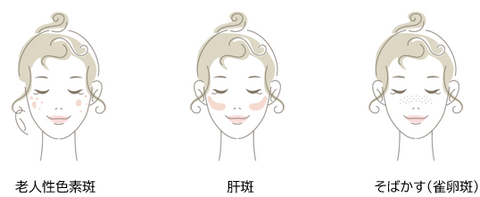
Aoharu's secrets to special care for each problem ~Spots & Dullness Vol.3~
Learn about the different types of spots and dullness!
In this third installment of our series on skin whitening care, we will explain the different types of spots and dullness. The causes of spots and dullness vary depending on the type. If you can imagine where the cause of your spots and dullness lies, your care and prevention will change, so be sure to understand the types of spots and dullness you have.
1.There are different types of spots!
Although we use the word "spots" in general, there are many different types of spots. First of all, it is important to determine which type your spots are. Here are some typical spots.
① Senile lentigo
These are commonly known as "spots" that often appear on the face and backs of the hands, which are easily affected by ultraviolet rays. They are characterized by a relatively clear border and dark color. Since they are caused by the accumulation of ultraviolet rays, they are more likely to appear in people who tanned when they were young, and more likely to appear as they get older.
This type of stain can be prevented with self-care.
② Melasma
It is a blemish that spreads symmetrically on the cheeks and other areas, and is characterized by being vague and indistinct when it first appears. It is most common in women in their 30s and 40s , and is thought to be related to female hormones.
Be careful not to rub your skin and irritate it, as this can make the spots darker and worsen. In addition to self-care with whitening products, there are also oral medications available.
③Freckles (Ephelides)
Unlike senile lentigo, this is a type of blemish that can be seen from childhood and is largely genetic . It darkens in the summer when UV rays are strong and lightens in the winter when they are weak, so it is essential to protect yourself from UV rays with sunscreen. There are limits to what you can do with self-care, so if you are concerned, we recommend consulting a specialist, such as visiting a clinic.
2. There are different types of dullness!
Just like age spots, there are different types of dullness! First, let's determine which type your dullness falls into.

① Brownish dullness
This type of skin has a brownish, dull, dull appearance. The surface of the skin looks brownish and dull because melanin has accumulated in the skin due to exposure to ultraviolet rays and friction .
In addition, the turnover cycle, in which skin cells are regenerated, is also closely related to dullness. The turnover cycle is said to be about 28 days in people in their 20s , but it is thought that the number of days increases as people get older because their metabolism slows down. If the turnover takes a long time, old keratin is more likely to remain on the surface of the skin, which causes dullness.
② Yellowish dullness
This type of skin has a yellowish, dull appearance overall. The main cause of yellowish dullness is glycation. Glycation occurs when proteins bind with excess sugar, and when this reaction occurs in the body, a substance called AGEs is produced, which has a negative effect on all tissues. When pancakes or cookies burn, they do so because the sugar contained in them binds with proteins from eggs and milk, becoming glycated and denatured into AGEs . AGEs are yellowish-brown in color, so when glycation occurs on the surface of the skin, the skin becomes yellowish and dull.
Glycation not only causes dullness, but is also a major enemy of the skin. When collagen, a protein, is glycated, it loses firmness and elasticity, causing sagging and wrinkles.
③ Reddish dullness
This type of rash occurs when small inflammations cause the blood vessels in the dermis to expand, causing redness to spread all over the skin, making it appear dull.
This is caused by inflammation due to ultraviolet rays, dryness, irritation from rubbing, etc. Inflammation stimulates melanocytes (pigment cells), which can lead to the production of melanin and cause brown discoloration.
These types of dullness may occur together, rather than just one. For example, accumulation of UV rays and glycation due to aging may cause brown and yellow dullness to appear at the same time, making the skin look extremely dull.
→See UV care items
→See drying related items
Things to be aware of when caring for dark spots and dull skin
So far, we have explained about whitening care three times. If you understand the characteristics of whitening ingredients and imagine their effect on the skin while caring for your skin, you will be able to feel the effects more easily, but as we have introduced this time, there are many types of spots and dullness, and the effective measures and whitening ingredients differ depending on the type. Even if it looks like a spot at first glance, it may actually be a freckle or mole, so in order to avoid wasting money, time, and effort, we recommend that you have a specialist such as a dermatologist diagnose it.
In addition, there are products, supplements, and oral medications that contain whitening ingredients that are prescribed by a doctor and are only available at clinics. While commercially available products have a low ratio of whitening ingredients, those sold at clinics have a higher ratio because they are intended to be used under the guidance of a doctor.
If you want whitening care that suits your skin type and concerns, please consult with a specialist at a clinic. At Aoharu Clinic ( https://www.aohalclinic.jp ), we also identify the symptoms of spots and dullness, and propose prescriptions that only a clinic can provide from the perspective of "treatment" that goes one step beyond skin care. We will introduce specific treatments in another blog post!
